steering wheel FIAT ULYSSE 2007 2.G User Guide
[x] Cancel search | Manufacturer: FIAT, Model Year: 2007, Model line: ULYSSE, Model: FIAT ULYSSE 2007 2.GPages: 254, PDF Size: 3.42 MB
Page 125 of 254
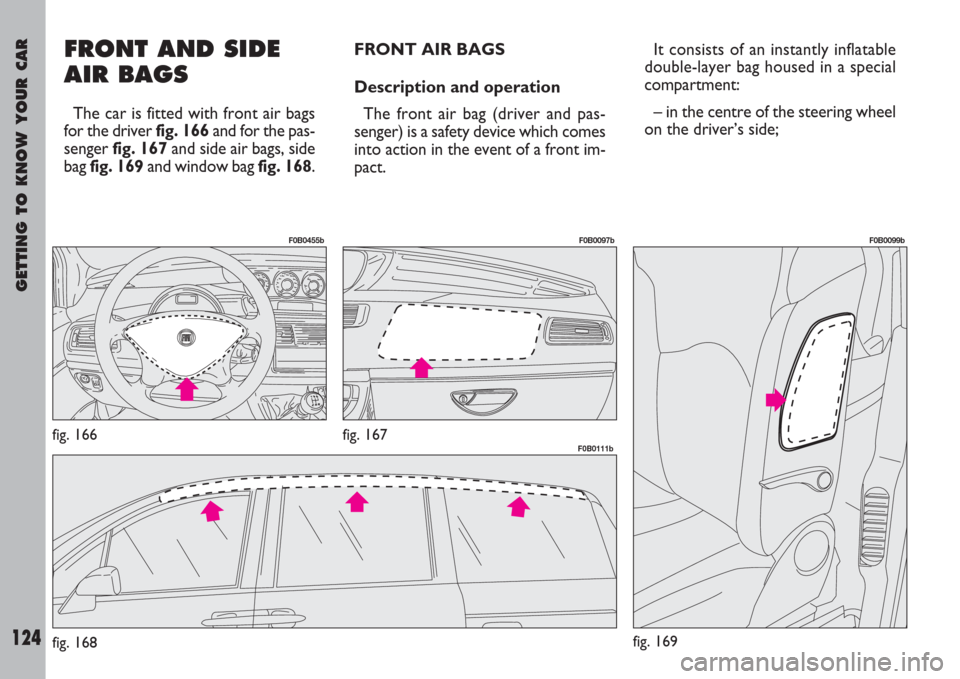
GETTING TO KNOW YOUR CAR
124fig. 168
F0B0111b
FRONT AND SIDE
AIR BAGS
The car is fitted with front air bags
for the driver fig. 166and for the pas-
senger fig. 167and side air bags, side
bag fig. 169and window bag fig. 168.FRONT AIR BAGS
Description and operation
The front air bag (driver and pas-
senger) is a safety device which comes
into action in the event of a front im-
pact.It consists of an instantly inflatable
double-layer bag housed in a special
compartment:
– in the centre of the steering wheel
on the driver’s side;
fig. 167
F0B0097b
fig. 169
F0B0099b
fig. 166
F0B0455b
Page 126 of 254
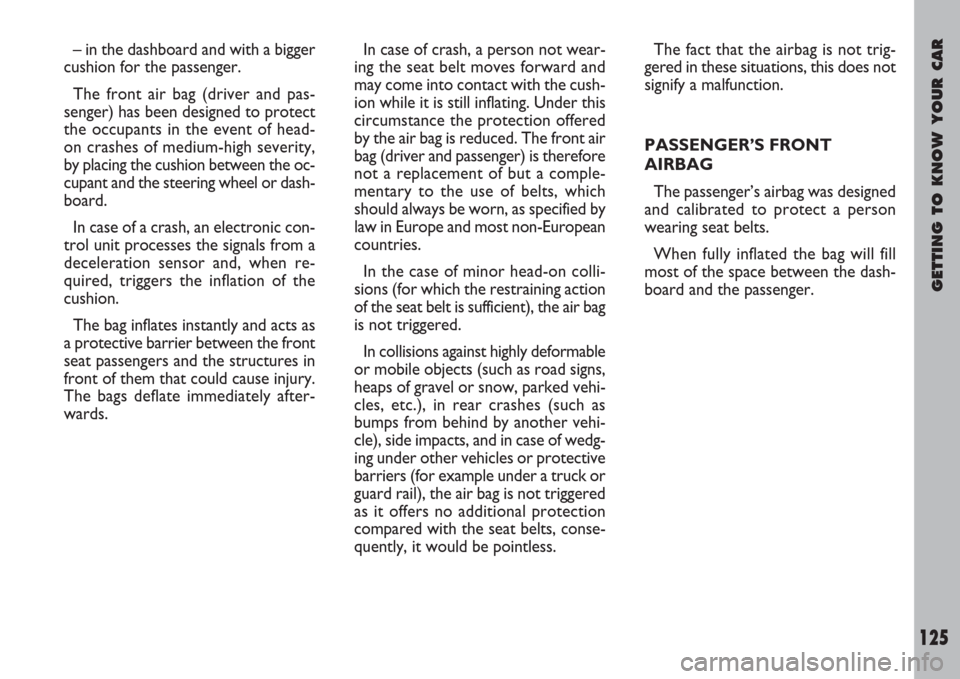
GETTING TO KNOW YOUR CAR
125
– in the dashboard and with a bigger
cushion for the passenger.
The front air bag (driver and pas-
senger) has been designed to protect
the occupants in the event of head-
on crashes of medium-high severity,
by placing the cushion between the oc-
cupant and the steering wheel or dash-
board.
In case of a crash, an electronic con-
trol unit processes the signals from a
deceleration sensor and, when re-
quired, triggers the inflation of the
cushion.
The bag inflates instantly and acts as
a protective barrier between the front
seat passengers and the structures in
front of them that could cause injury.
The bags deflate immediately after-
wards.In case of crash, a person not wear-
ing the seat belt moves forward and
may come into contact with the cush-
ion while it is still inflating. Under this
circumstance the protection offered
by the air bag is reduced. The front air
bag (driver and passenger) is therefore
not a replacement of but a comple-
mentary to the use of belts, which
should always be worn, as specified by
law in Europe and most non-European
countries.
In the case of minor head-on colli-
sions (for which the restraining action
of the seat belt is sufficient), the air bag
is not triggered.
In collisions against highly deformable
or mobile objects (such as road signs,
heaps of gravel or snow, parked vehi-
cles, etc.), in rear crashes (such as
bumps from behind by another vehi-
cle), side impacts, and in case of wedg-
ing under other vehicles or protective
barriers (for example under a truck or
guard rail), the air bag is not triggered
as it offers no additional protection
compared with the seat belts, conse-
quently, it would be pointless.The fact that the airbag is not trig-
gered in these situations, this does not
signify a malfunction.
PASSENGER’S FRONT
AIRBAG
The passenger’s airbag was designed
and calibrated to protect a person
wearing seat belts.
When fully inflated the bag will fill
most of the space between the dash-
board and the passenger.
Page 130 of 254
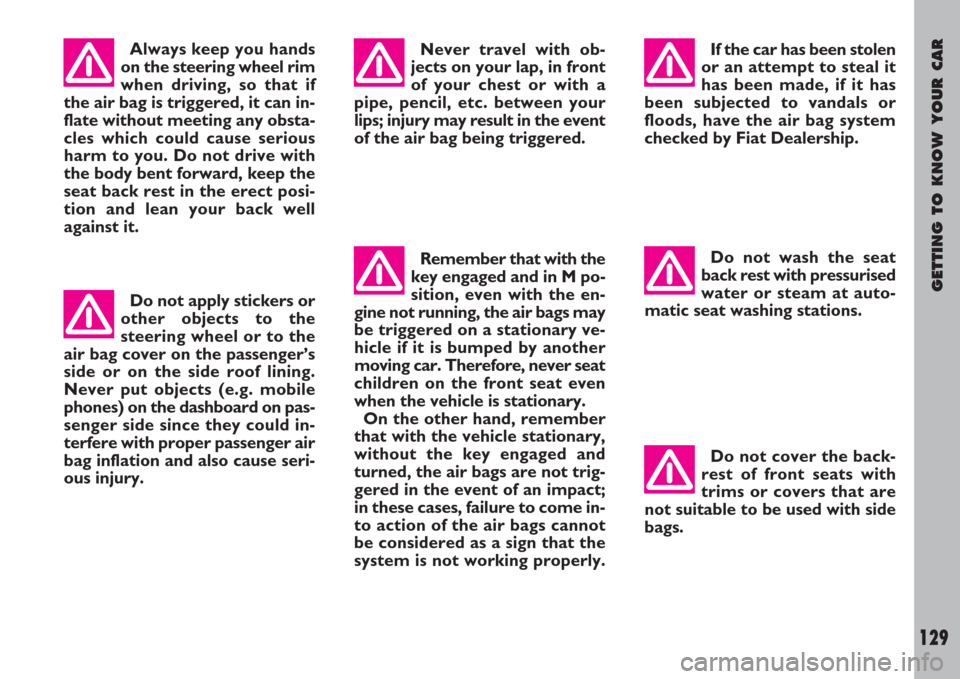
Remember that with the
key engaged and in M po-
sition, even with the en-
gine not running, the air bags may
be triggered on a stationary ve-
hicle if it is bumped by another
moving car. Therefore, never seat
children on the front seat even
when the vehicle is stationary.
On the other hand, remember
that with the vehicle stationary,
without the key engaged and
turned, the air bags are not trig-
gered in the event of an impact;
in these cases, failure to come in-
to action of the air bags cannot
be considered as a sign that the
system is not working properly.
GETTING TO KNOW YOUR CAR
129
Never travel with ob-
jects on your lap, in front
of your chest or with a
pipe, pencil, etc. between your
lips; injury may result in the event
of the air bag being triggered.If the car has been stolen
or an attempt to steal it
has been made, if it has
been subjected to vandals or
floods, have the air bag system
checked by Fiat Dealership.
Do not wash the seat
back rest with pressurised
water or steam at auto-
matic seat washing stations.
Do not cover the back-
rest of front seats with
trims or covers that are
not suitable to be used with side
bags. Always keep you hands
on the steering wheel rim
when driving, so that if
the air bag is triggered, it can in-
flate without meeting any obsta-
cles which could cause serious
harm to you. Do not drive with
the body bent forward, keep the
seat back rest in the erect posi-
tion and lean your back well
against it.
Do not apply stickers or
other objects to the
steering wheel or to the
air bag cover on the passenger’s
side or on the side roof lining.
Never put objects (e.g. mobile
phones) on the dashboard on pas-
senger side since they could in-
terfere with proper passenger air
bag inflation and also cause seri-
ous injury.
Page 139 of 254
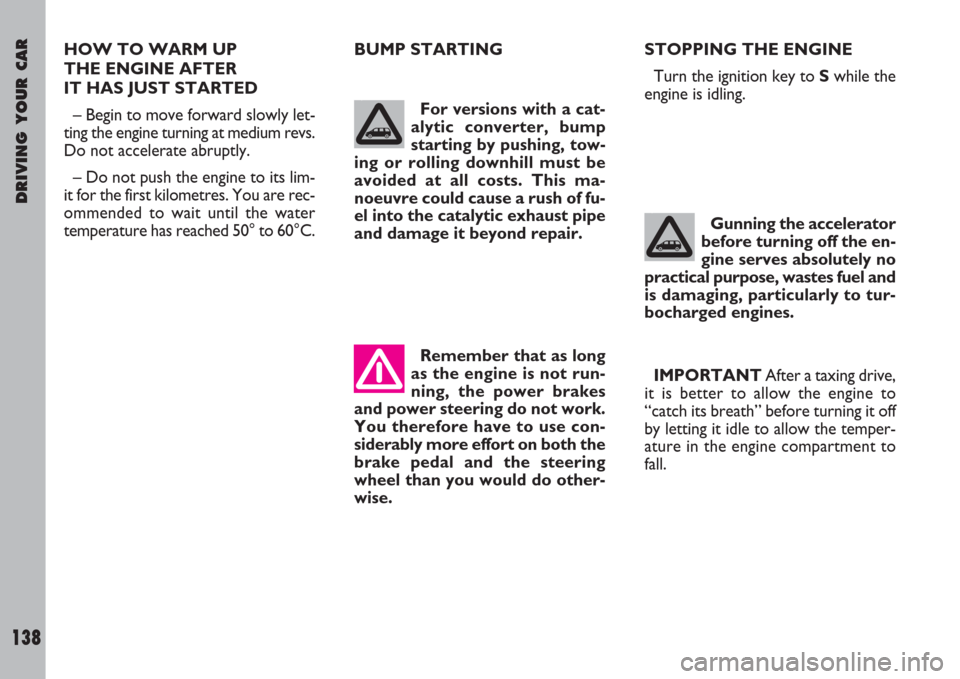
DRIVING YOUR CAR
138
HOW TO WARM UP
THE ENGINE AFTER
IT HAS JUST STARTED
– Begin to move forward slowly let-
ting the engine turning at medium revs.
Do not accelerate abruptly.
– Do not push the engine to its lim-
it for the first kilometres. You are rec-
ommended to wait until the water
temperature has reached 50° to 60°C.BUMP STARTING
For versions with a cat-
alytic converter, bump
starting by pushing, tow-
ing or rolling downhill must be
avoided at all costs. This ma-
noeuvre could cause a rush of fu-
el into the catalytic exhaust pipe
and damage it beyond repair.STOPPING THE ENGINE
Turn the ignition key to Swhile the
engine is idling.
Remember that as long
as the engine is not run-
ning, the power brakes
and power steering do not work.
You therefore have to use con-
siderably more effort on both the
brake pedal and the steering
wheel than you would do other-
wise.
Gunning the accelerator
before turning off the en-
gine serves absolutely no
practical purpose, wastes fuel and
is damaging, particularly to tur-
bocharged engines.
IMPORTANTAfter a taxing drive,
it is better to allow the engine to
“catch its breath” before turning it off
by letting it idle to allow the temper-
ature in the engine compartment to
fall.
Page 141 of 254
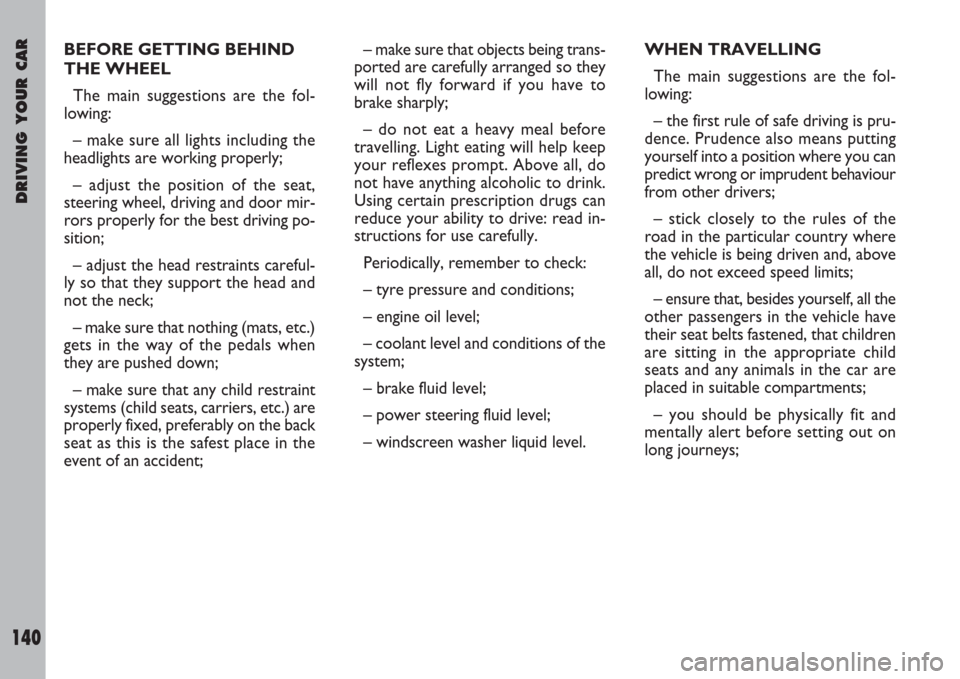
DRIVING YOUR CAR
140
BEFORE GETTING BEHIND
THE WHEEL
The main suggestions are the fol-
lowing:
– make sure all lights including the
headlights are working properly;
– adjust the position of the seat,
steering wheel, driving and door mir-
rors properly for the best driving po-
sition;
– adjust the head restraints careful-
ly so that they support the head and
not the neck;
– make sure that nothing (mats, etc.)
gets in the way of the pedals when
they are pushed down;
– make sure that any child restraint
systems (child seats, carriers, etc.) are
properly fixed, preferably on the back
seat as this is the safest place in the
event of an accident;– make sure that objects being trans-
ported are carefully arranged so they
will not fly forward if you have to
brake sharply;
– do not eat a heavy meal before
travelling. Light eating will help keep
your reflexes prompt. Above all, do
not have anything alcoholic to drink.
Using certain prescription drugs can
reduce your ability to drive: read in-
structions for use carefully.
Periodically, remember to check:
– tyre pressure and conditions;
– engine oil level;
– coolant level and conditions of the
system;
– brake fluid level;
– power steering fluid level;
– windscreen washer liquid level.WHEN TRAVELLING
The main suggestions are the fol-
lowing:
– the first rule of safe driving is pru-
dence. Prudence also means putting
yourself into a position where you can
predict wrong or imprudent behaviour
from other drivers;
– stick closely to the rules of the
road in the particular country where
the vehicle is being driven and, above
all, do not exceed speed limits;
– ensure that, besides yourself, all the
other passengers in the vehicle have
their seat belts fastened, that children
are sitting in the appropriate child
seats and any animals in the car are
placed in suitable compartments;
– you should be physically fit and
mentally alert before setting out on
long journeys;
Page 142 of 254
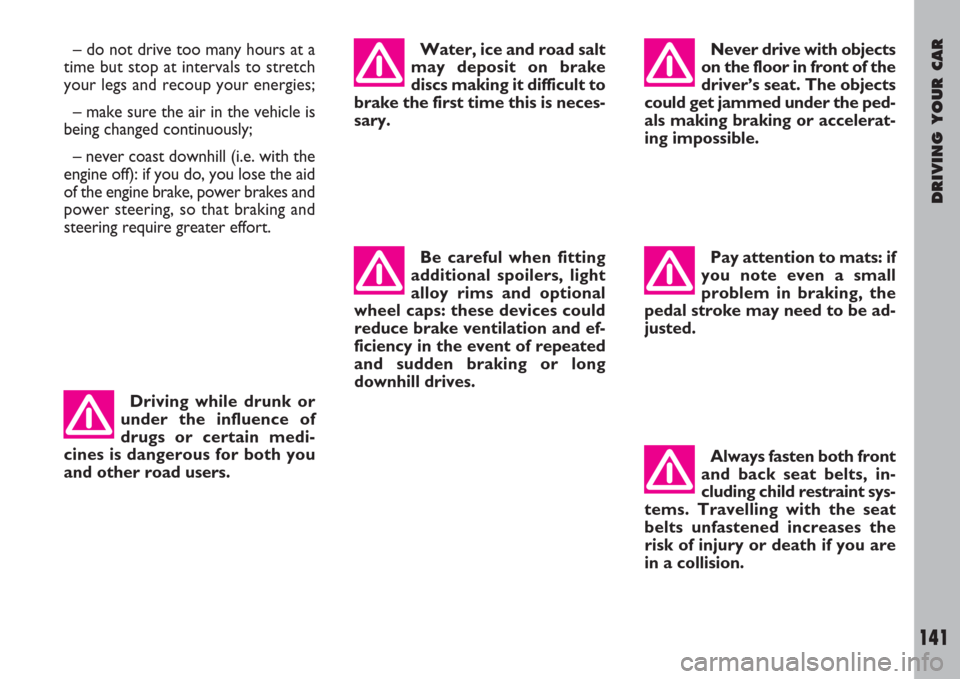
DRIVING YOUR CAR
141
Be careful when fitting
additional spoilers, light
alloy rims and optional
wheel caps: these devices could
reduce brake ventilation and ef-
ficiency in the event of repeated
and sudden braking or long
downhill drives.Never drive with objects
on the floor in front of the
driver’s seat. The objects
could get jammed under the ped-
als making braking or accelerat-
ing impossible.
Driving while drunk or
under the influence of
drugs or certain medi-
cines is dangerous for both you
and other road users.Pay attention to mats: if
you note even a small
problem in braking, the
pedal stroke may need to be ad-
justed.
Always fasten both front
and back seat belts, in-
cluding child restraint sys-
tems. Travelling with the seat
belts unfastened increases the
risk of injury or death if you are
in a collision.
Water, ice and road salt
may deposit on brake
discs making it difficult to
brake the first time this is neces-
sary.– do not drive too many hours at a
time but stop at intervals to stretch
your legs and recoup your energies;
– make sure the air in the vehicle is
being changed continuously;
– never coast downhill (i.e. with the
engine off): if you do, you lose the aid
of the engine brake, power brakes and
power steering, so that braking and
steering require greater effort.
Page 155 of 254
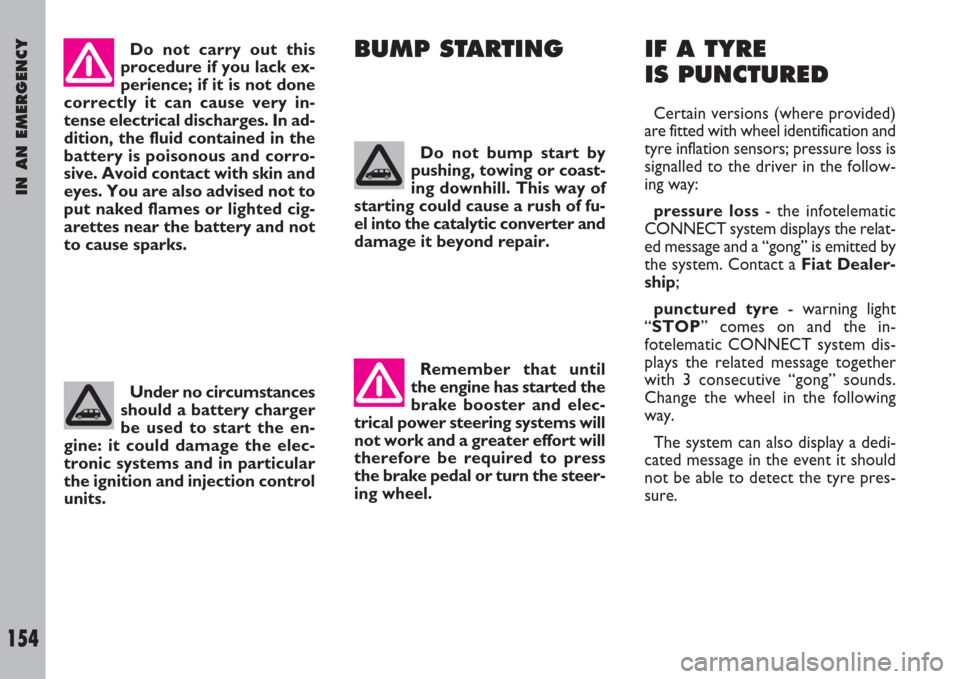
IN AN EMERGENCY
154
Do not carry out this
procedure if you lack ex-
perience; if it is not done
correctly it can cause very in-
tense electrical discharges. In ad-
dition, the fluid contained in the
battery is poisonous and corro-
sive. Avoid contact with skin and
eyes. You are also advised not to
put naked flames or lighted cig-
arettes near the battery and not
to cause sparks.
Remember that until
the engine has started the
brake booster and elec-
trical power steering systems will
not work and a greater effort will
therefore be required to press
the brake pedal or turn the steer-
ing wheel.IF A TYRE
IS PUNCTURED
Certain versions (where provided)
are fitted with wheel identification and
tyre inflation sensors; pressure loss is
signalled to the driver in the follow-
ing way:
pressure loss- the infotelematic
CONNECT system displays the relat-
ed message and a “gong” is emitted by
the system. Contact a Fiat Dealer-
ship;
punctured tyre- warning light
“STOP” comes on and the in-
fotelematic CONNECT system dis-
plays the related message together
with 3 consecutive “gong” sounds.
Change the wheel in the following
way.
The system can also display a dedi-
cated message in the event it should
not be able to detect the tyre pres-
sure. Under no circumstances
should a battery charger
be used to start the en-
gine: it could damage the elec-
tronic systems and in particular
the ignition and injection control
units.
BUMP STARTING
Do not bump start by
pushing, towing or coast-
ing downhill. This way of
starting could cause a rush of fu-
el into the catalytic converter and
damage it beyond repair.
Page 182 of 254
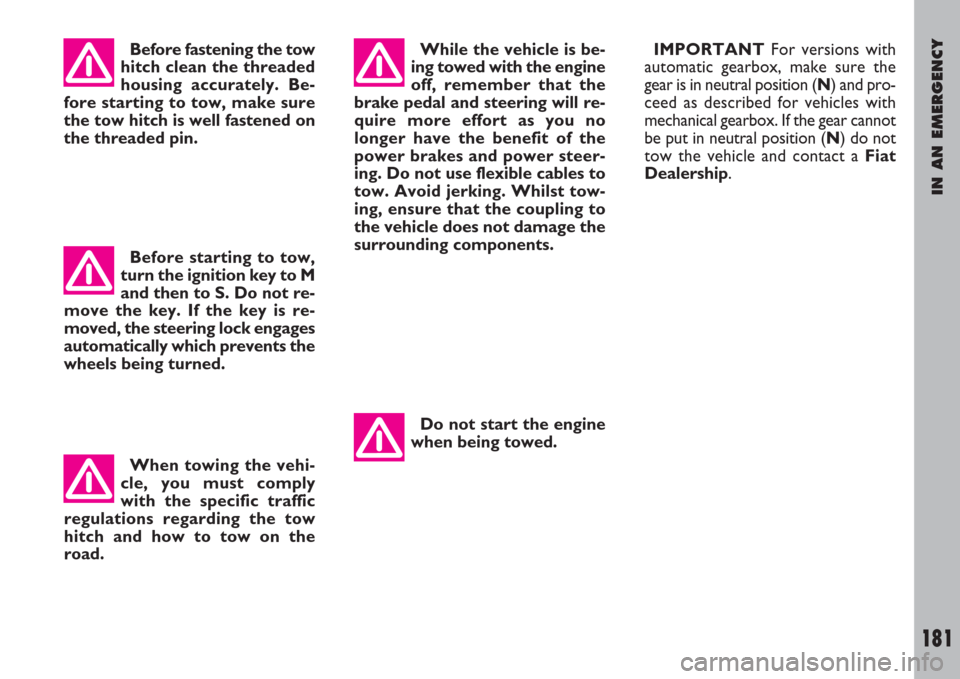
IN AN EMERGENCY
181
Before fastening the tow
hitch clean the threaded
housing accurately. Be-
fore starting to tow, make sure
the tow hitch is well fastened on
the threaded pin.While the vehicle is be-
ing towed with the engine
off, remember that the
brake pedal and steering will re-
quire more effort as you no
longer have the benefit of the
power brakes and power steer-
ing. Do not use flexible cables to
tow. Avoid jerking. Whilst tow-
ing, ensure that the coupling to
the vehicle does not damage the
surrounding components.IMPORTANTFor versions with
automatic gearbox, make sure the
gear is in neutral position (N) and pro-
ceed as described for vehicles with
mechanical gearbox. If the gear cannot
be put in neutral position (N) do not
tow the vehicle and contact a Fiat
Dealership.
Before starting to tow,
turn the ignition key to M
and then to S. Do not re-
move the key. If the key is re-
moved, the steering lock engages
automatically which prevents the
wheels being turned.
When towing the vehi-
cle, you must comply
with the specific traffic
regulations regarding the tow
hitch and how to tow on the
road.
Do not start the engine
when being towed.
Page 197 of 254
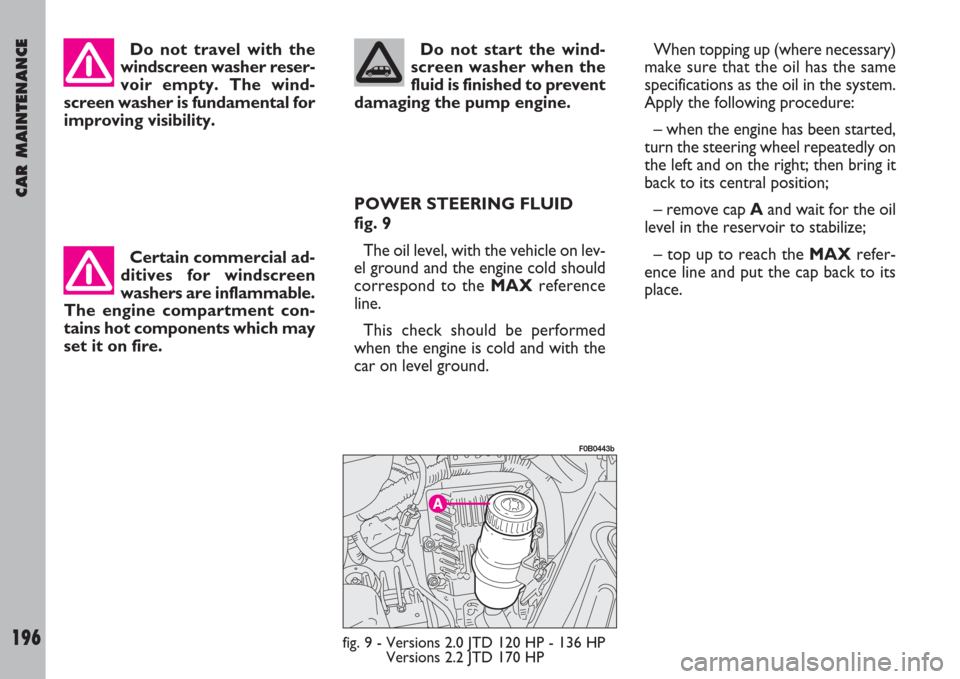
Do not travel with the
windscreen washer reser-
voir empty. The wind-
screen washer is fundamental for
improving visibility.Do not start the wind-
screen washer when the
fluid is finished to prevent
damaging the pump engine.
POWER STEERING FLUID
fig. 9
The oil level, with the vehicle on lev-
el ground and the engine cold should
correspond to the MAX reference
line.
This check should be performed
when the engine is cold and with the
car on level ground.When topping up (where necessary)
make sure that the oil has the same
specifications as the oil in the system.
Apply the following procedure:
– when the engine has been started,
turn the steering wheel repeatedly on
the left and on the right; then bring it
back to its central position;
– remove cap Aand wait for the oil
level in the reservoir to stabilize;
– top up to reach the MAX refer-
ence line and put the cap back to its
place. Certain commercial ad-
ditives for windscreen
washers are inflammable.
The engine compartment con-
tains hot components which may
set it on fire.
CAR MAINTENANCE
196fig. 9 - Versions 2.0 JTD 120 HP - 136 HP
Versions 2.2 JTD 170 HP
F0B0443b
Page 207 of 254
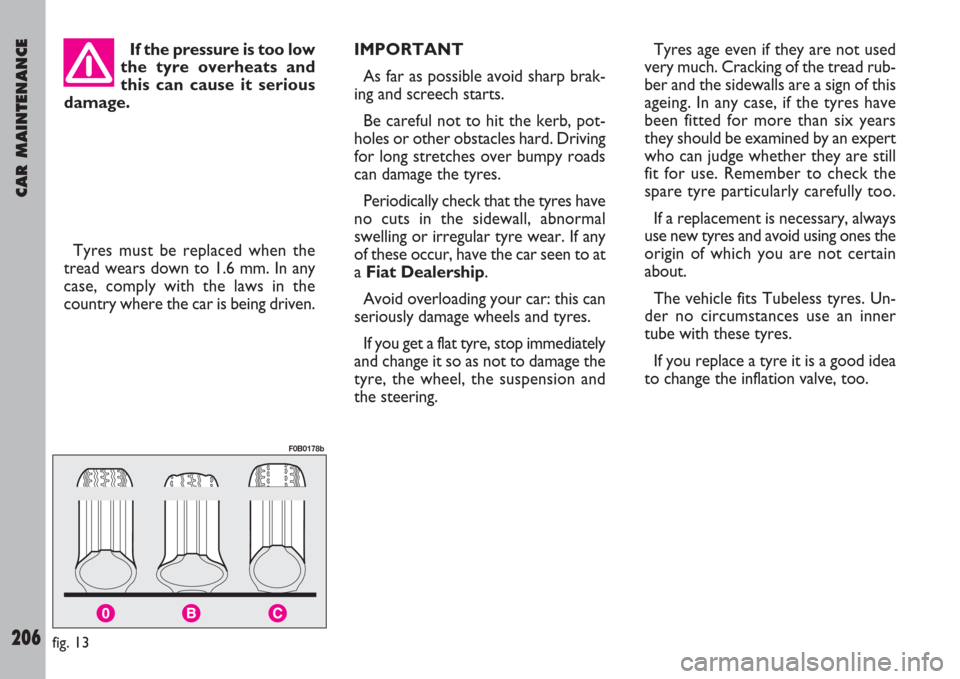
CAR MAINTENANCE
206
If the pressure is too low
the tyre overheats and
this can cause it serious
damage.
Tyres must be replaced when the
tread wears down to 1.6 mm. In any
case, comply with the laws in the
country where the car is being driven.IMPORTANT
As far as possible avoid sharp brak-
ing and screech starts.
Be careful not to hit the kerb, pot-
holes or other obstacles hard. Driving
for long stretches over bumpy roads
can damage the tyres.
Periodically check that the tyres have
no cuts in the sidewall, abnormal
swelling or irregular tyre wear. If any
of these occur, have the car seen to at
a Fiat Dealership.
Avoid overloading your car: this can
seriously damage wheels and tyres.
If you get a flat tyre, stop immediately
and change it so as not to damage the
tyre, the wheel, the suspension and
the steering.Tyres age even if they are not used
very much. Cracking of the tread rub-
ber and the sidewalls are a sign of this
ageing. In any case, if the tyres have
been fitted for more than six years
they should be examined by an expert
who can judge whether they are still
fit for use. Remember to check the
spare tyre particularly carefully too.
If a replacement is necessary, always
use new tyres and avoid using ones the
origin of which you are not certain
about.
The vehicle fits Tubeless tyres. Un-
der no circumstances use an inner
tube with these tyres.
If you replace a tyre it is a good idea
to change the inflation valve, too.
fig. 13
F0B0178b